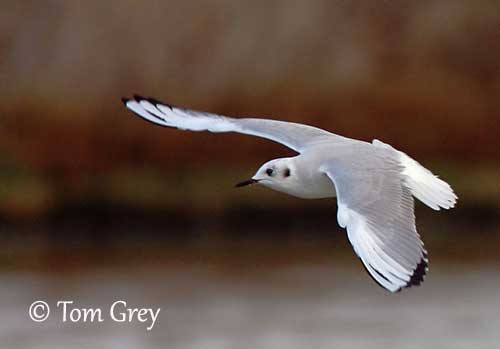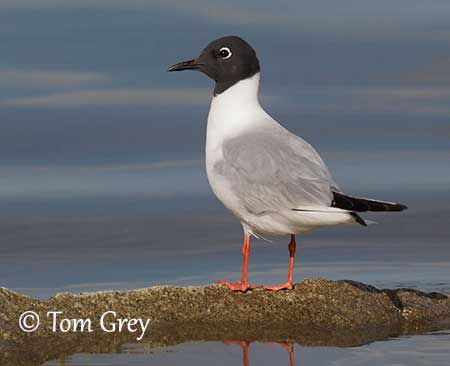
Fr : Mouette de Bonaparte
Ang : Bonaparte’s Gull
All : Bonapartemöwe
Esp : Gaviota de Bonaparte
Ita : Gabbiano di Bonaparte
Nd : Kleine Kokmeeuw
Sd : trädmås
Photographer:
Tom Grey
Tom Grey's Bird Pictures & Tom Grey's Bird Pictures 2
Text by Nicole Bouglouan
Sources:
HANDBOOK OF THE BIRDS OF THE WORLD Vol 3 by Josep del Hoyo-Andrew Elliott-Jordi Sargatal - Lynx Edicions - ISBN: 8487334202
A GUIDE TO THE BIRDS OF MEXICO AND NORTHERN CENTRAL AMERICA by Steve N. G. Howell, Sophie Webb - Oxford University Press - ISBN: 0198540124
FIELD GUIDE TO THE BIRDS OF NORTH AMERICA - National Geographic Society -ISBN: 0792274512
What Bird-The ultimate Bird Guide (Mitchell Waite)
Bird Web (Seattle Audubon Society)
The Birds of North America online
All About Birds (Cornell Lab of Ornithology)
Wikipedia, the free encyclopaedia
Alaska Seabird Information Series
Bonaparte’s Gull
Chroicocephalus philadelphia
Charadriiformes Order – Laridae Family
INTRODUCTION:
The Bonaparte’s Gull is now placed in the genus Chroicocephalus. It is one of the smallest gulls of North America. It differs from other Laridae in two ways. It rarely scavenges at garbage dumps, and it nests in trees, not on the ground.
It breeds at the edge of the boreal forest in North America, from S Alaska and W Canada to Quebec. It nests in vicinity of water, usually at the wooded edges of marshes and ponds, or on islands. It winters along North American coasts and in the Great Lakes.
The name of this gull pays tribute to Charles Lucien Bonaparte, a French ornithologist, nephew of Napoleon Bonaparte.
The Bonaparte’s Gull is not globally threatened and its population is suspected to be increasing.

DESCRIPTION OF THE BIRD:
Biometrics:
Length: 28-30 cm
Wingspan: 78-84 cm
Weight: 170-230 g
The Bonaparte’s Gull in breeding plumage is very similar to the Black-headed Gull (C. ridibundus), but it is smaller overall. It has uniform sooty-black hood on face and crown, contrasting with the white eye-crescents. Neck and entire underparts are white. On the upperparts, back and upperwing, including the inner primaries, are grey, whereas the outer primaries are white and almost translucent, with black tips. The tail is white.
The slender bill is black. The eyes are blackish, surrounded by narrow, red eyering. Legs and webbed feet are orange-red.
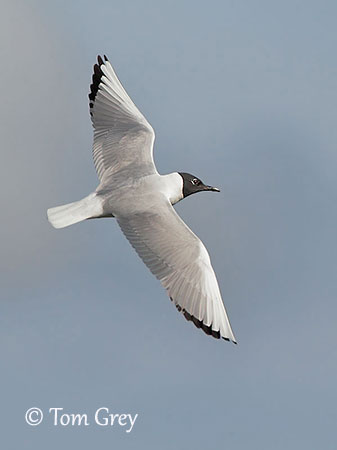
The non-breeding adult lacks the black hood. The head is white, with dusky ear spot.
Male and female are similar.
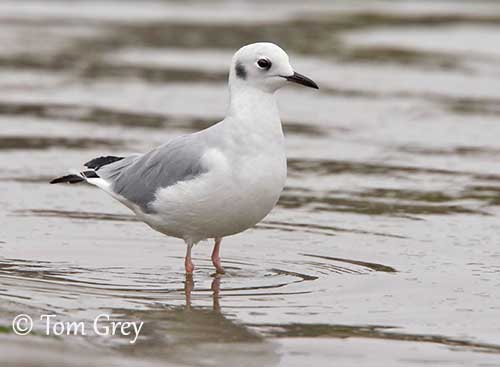
Juvenile and first winter have a dark brown carpal bar on the leading edge of the wing, a dark band over secondaries, and a terminal black tail band. Legs and feet are pale pinkish.
The first summer bird shows sometimes a partial dark hood or partly mottled head.
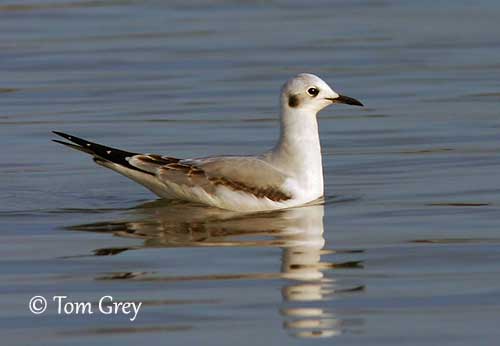
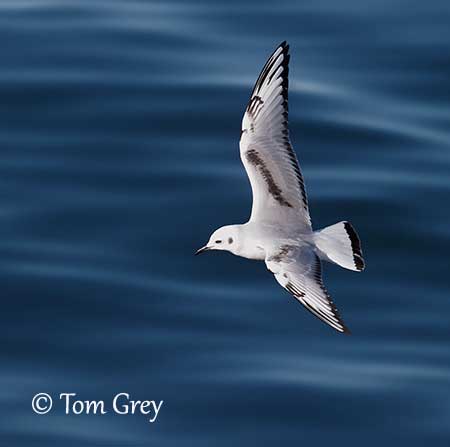
RANGE:
The Bonaparte’s Gull breeds in W Alaska and S British Columbia, E to E Quebec (SE Canada) and probably N Maine (NE USA).
It winters along the coasts of North America, on Pacific coast S to Mexico, and on Atlantic coast S to Florida and Greater Antilles.
During mild winters, it is present from the Great Lakes to Gulf of Mexico.
HABITAT:
The Bonaparte’s Gull breeds at the edge of the boreal forest, usually in coniferous trees near lakes and marshes, in coastal and inland areas of taiga zone. It is usually seen at low elevations, but it may occur up to 600 metres in Alaska. It often arrives on the breeding grounds before snow-melt.
During migration and winter, it frequents a variety of waters such as inland rivers and lakes, and coastal lagoons and estuaries. It sometimes occurs well offshore on ocean.
Large concentrations of birds are seen at sewage ponds, feeding on abundant insects.
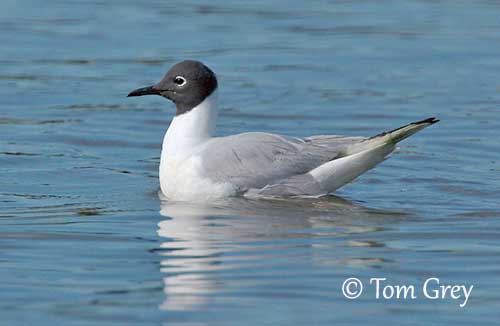
CALLS AND SONGS: SOUNDS BY XENO-CANTO
The Bonaparte’s Gull gives low, rasping “kwah” and “rehow”, also a louder, plaintive “whee-hooah” and other nasal growling sounds.
BEHAVIOUR IN THE WILD:
The Bonaparte’s Gull feeds primarily on insects during the breeding season, but it also consumes small fish (sand lances and herrings), shrimps of genus Euphausia, amphipods and marine worms. Insects are eaten on inland nesting areas.
It forages in flight, dipping to the surface and diving, but mainly by surface-seizing. Swarming insects can be caught by aerial hawking. It forages actively in different ways, and sometimes in large flocks of up to 2000 individuals over incoming tide.
However, this species rarely scavenges at carrion and garbage dumps.
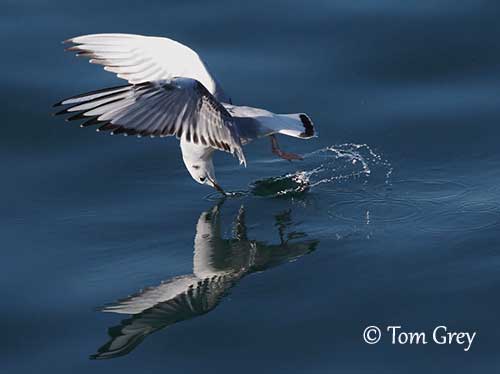
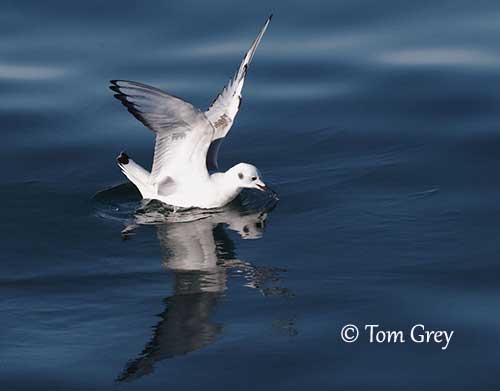
The breeding behavior of the Bonaparte’s Gull is poorly known. However, unlike most Laridae species, it is often non-colonial breeder, but a few nests may be clumped in a small area of about 1km². It may also nest as isolated pairs.
This species nests in trees, usually coniferous trees of genus Picea and Larix. The courtship behavior takes place mostly in trees. Prior to copulation, delivery of nest material between mates is often recorded.
The Bonaparte’s Gull is migratory. It leaves the breeding areas in August. They often leave in loose flocks becoming larger as they reach the Great Lakes and the coast. The winter flocks may move around in response to food resources. They return to their breeding grounds in early May.
The Bonaparte’s Gull has buoyant, tern-like flight with rapid wingbeats.
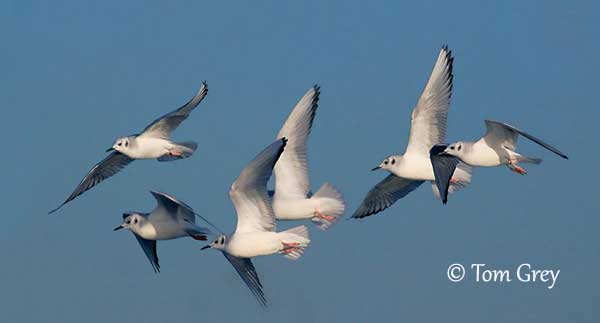
REPRODUCTION OF THIS SPECIES:
The breeding season takes place in spring, with the laying in late May. The nest is placed in tree, in bog pond or marsh.
The flat structure is built on horizontal branch, between 4 and 15 metres above the ground, sometimes higher. It is made with twigs and leaves held together by grasses. It is lined with grass and moss.
The female lays 2-3 olive to buff eggs with brown markings. Both adults incubate during 23-24 days. At hatching, the chicks have brownish cinnamon down with irregular darker spots and blotches above, and unmarked pinkish cinnamon underparts. They are fed by both parents. The age of first flight is unknown.
When an intruder approaches the nest, the adults call loudly from nearby treetops or fly about.
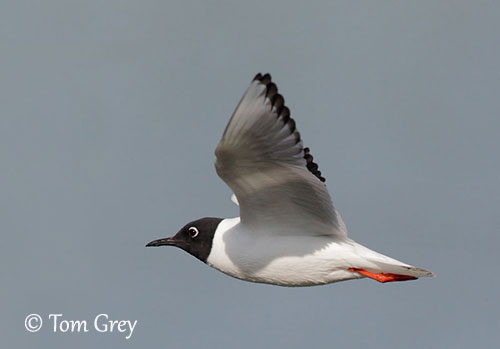
PROTECTION / THREATS / STATUS:
The Bonaparte’s Gull breeds in remote nesting areas, far from human disturbance.
The global population is estimated to number 85,000/175,000 pairs. This population is suspected to be increasing.
The Bonaparte’s Gull is currently evaluated as Least Concern. This gull remains among the least studied of any gulls in North America.
